United States incarceration rate
In September 2013, the incarceration rate of the United States of America was the highest in the world at 716 per 100,000 of the national population. While the United States represents about 4.4 percent of the world's population, it houses around 22 percent of the world's prisoners.[1] Corrections (which includes prisons, jails, probation, and parole) cost around $74 billion in 2007 according to the U.S. Bureau of Justice Statistics.[2][3]
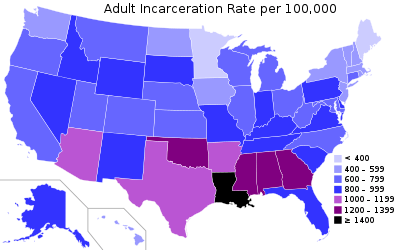
At the end of 2016, the Prison Policy Initiative, a non-profit organization for decarceration, estimated that in the United States, about 2,298,300 people were incarcerated out of a population of 324.2 million. This means that 0.7% of the population was behind bars. Of those who were incarcerated, about 1,316,000 people were in state prison, 615,000 in local jails, 225,000 in federal prisons, 48,000 in youth correctional facilities, 34,000 in immigration detention camps, 22,000 in involuntary commitment, 11,000 in territorial prisons, 2,500 in Indian Country jails, and 1,300 in United States military prisons.[4]
Prison and jail population
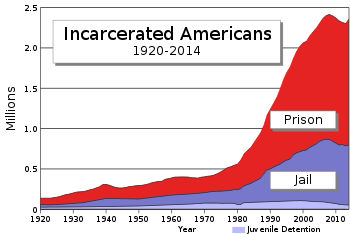

Total U.S. incarceration (prisons and jails) peaked in 2008. Total correctional population peaked in 2007.[5] If all prisoners are counted (including those juvenile, territorial, U.S. Immigration and Customs Enforcement (ICE) (immigration detention), Indian country, and military), then in 2008 the United States had around 24.7% of the world's 9.8 million prisoners.[6][7][8]
The United States has the highest documented incarceration rate in the world, at 754 per 100,000 (as of 2009).[9][10] As of December 31, 2010, the International Centre for Prison Studies (ICPS) at King's College London estimated 2,266,832 prisoners from a total population of 310.64 million as of this date (730 per 100,000 in 2010).[11]
This number comprises local jails with a nominal capacity of 866,782 inmates occupied at 86.4% (June 6, 2010), state prisons with a nominal capacity of approximately 1,140,500 occupied at approximately 115% (December 31, 2010), and federal prisons with a nominal capacity of 126,863 occupied at 136.0% (December 31, 2010). Of this number, 21.5% are pretrial detainees (December 31, 2010), 8.7% are female prisoners (December 31, 2010), 0.4% are juveniles (June 6, 2009), and 5.9% are foreign prisoners (June 30, 2007).[11]
The imprisonment rate varies widely by state; Louisiana surpasses this by about 100%, but Maine incarcerates at about a fifth this rate. A report released 28 February 2008, indicates that more than 1 in 100 adults in the United States are in prison.[12]
According to a U.S. Department of Justice report published in 2006, over 7.2 million people were at that time in prison, on probation, or on parole (released from prison with restrictions). That means roughly 1 in every 32 adult Americans are under some sort of criminal justice system control.[13][14]
Growth

In the last forty years, incarceration has increased with rates upwards of 500% despite crime rates decreasing nationally.[15] Between the years 2001 and 2012, crime rates (both property and violent crimes) have consistently declined at a rate of 22% after already falling an additional 30% in years prior between 1991 and 2001.[16] As of 2012, there are 710 people per every 100,000 U.S. residents in the United States that are imprisoned in either local jails, state prisons, federal prisons, and privately operated facilities.[16] This correlates to incarcerating a number close to almost a quarter of the prison population in the entire world.[17] Mass incarceration is an intervening variable to more incarceration.[18]
The Bureau of Justice Statistics has released a study which finds that, despite the total number of prisoners incarcerated for drug-related offenses increasing by 57,000 between 1997 and 2004, the proportion of drug offenders to total prisoners in State prison populations stayed steady at 21%. The percentage of Federal prisoners serving time for drug offenses declined from 63% in 1997 to 55% in that same period.[19] In the twenty-five years since the passage of the Anti-Drug Abuse Act of 1986, the United States penal population rose from around 300,000 to more than two million.[20] Between 1986 and 1991, African-American women's incarceration in state prisons for drug offenses increased by 828 percent.[21]
In 2009, the U.S. Department of Justice announced that the growth rate of the state prison population had fallen to its lowest since 2006, but it still had a 0.2% growth-rate compared to the total U.S. prison population.[22] The California state prison system population fell in 2009, the first year that populations had fallen in 38 years.[23]
When looking at specific populations within the criminal justice system the growth rates are vastly different. In 1977, there were just slightly more than eleven thousand incarcerated women. By 2004, the number of women under state or federal prison had increased by 757 percent, to more than 111,000, and the percentage of women in prison has increased every year, at roughly double the rate of men, since 2000.[24] The rate of incarcerated women has expanded at about 4.6% annually between 1995 and 2005 with women now accounting for 7% of the population in state and federal prisons.
Comparison with other countries
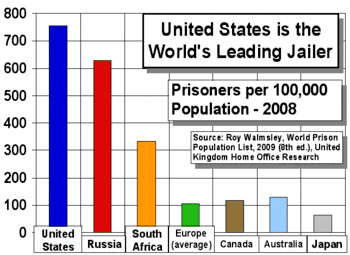
Comparing some countries with similar percentages of immigrants, Germany has an incarceration rate of 76 per 100,000 population (as of 2014),[25] Italy is 85 per 100,000 (as of 2015),[26] and Saudi Arabia is 161 per 100,000 (as of 2013).[27] Comparing other countries with a zero tolerance policy for illegal drugs, the rate of Russia is 455 per 100,000 (as of 2015),[28] Kazakhstan is 275 per 100,000 (as of 2015),[29] Singapore is 220 per 100,000 (as of 2014),[30] and Sweden is 60 per 100,000 (as of 2014).[31]
Causes
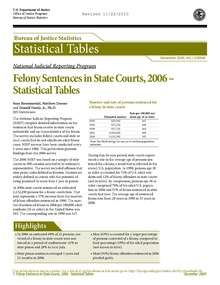
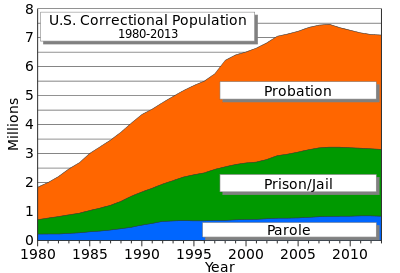
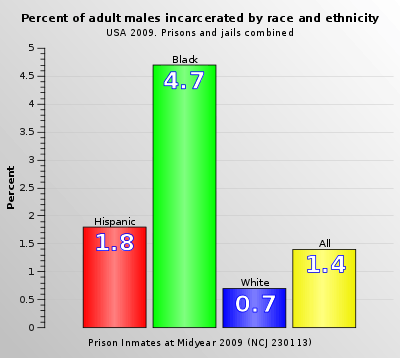
A 2014 report by the National Research Council identified two main causes of the increase in the United States' incarceration rate over the previous 40 years: longer prison sentences and increases in the likelihood of imprisonment. The same report found that longer prison sentences were the main driver of increasing incarceration rates since 1990.[33]
Increased sentencing laws
Even though there are other countries that commit more inmates to prison annually, the fact that the United States keeps their prisoners longer causes the total rate to become higher. To give an example, the average burglary sentence in the United States is 16 months, compared to 5 months in Canada and 7 months in England.[34]
Looking at reasons for imprisonment will further clarify why the incarceration rate and length of sentences are so high. The practice of imposing longer prison sentences on repeat offenders is common in many countries but the three-strikes laws in the U.S. with mandatory 25 year imprisonment — implemented in many states in the 1990s — are statutes enacted by state governments in the United States which mandate state courts to impose harsher sentences on habitual offenders who are previously convicted of two prior serious criminal offenses and then commit a third.
The Violent Crime Control and Law Enforcement Act of 1994 may have had a minor effect on mass incarceration.[35]
Economic and age contributions
Crime rates in low-income areas are much higher than in middle to high class areas. As a result, Incarceration rates in low-income areas are much higher than in wealthier areas due to these high crime rates.[36] When the incarcerated or criminal is a youth, there is a significant impact on the individual and rippling effects on entire communities. Social capital is lost when an individual is incarcerated. How much social capital is lost is hard to accurately estimate, however Aizer and Doyle found a strong positive correlation between lower income as an adult if an individual is incarcerated in their youth in comparison to those who are not incarcerated.[37] 63 percent to 66 percent of those involved in crimes are under the age of thirty.[36] People incarcerated at a younger age lose the capability to invest in themselves and in their communities. Their children and families become susceptible to financial burden preventing them from escaping low-income communities. This contributes to the recurring cycle of poverty that is positively correlated with incarceration.[38] Poverty rates have not been curbed despite steady economic growth. Poverty is not the sole dependent variable for increasing incarceration rates. Incarceration leads to more incarceration by putting families and communities at a dynamic social disadvantage.[39]
Drug sentencing laws
The "War on Drugs" is a policy that was initiated by Richard Nixon with the Comprehensive Drug Abuse Prevention and Control Act of 1970 and vigorously pursued by Ronald Reagan.[40] By 2010, drug offenders in federal prison had increased to 500,000 per year, up from 41,000 in 1985. According to Michelle Alexander, drug related charges accounted for more than half the rise in state prisoners between 1985 and 2000. 31 million people have been arrested on drug related charges, approximately 1 in 10 Americans.[41][42] In contrast, John Pfaff of Fordham Law School has accused Alexander of exaggerating the influence of the War on Drugs on the rise in the United States' incarceration rate: according to him, the percent of state prisoners whose primary offense was drug-related peaked at 22% in 1990.[43] The Brookings Institution reconciles the differences between Alexander and Pfaff by explaining two ways to look at the prison population as it relates to drug crimes, concluding "The picture is clear: Drug crimes have been the predominant reason for new admissions into state and federal prisons in recent decades" and "rolling back the war on drugs would not, as Pfaff and Urban Institute scholars maintain, totally solve the problem of mass incarceration, but it could help a great deal, by reducing exposure to prison."[44]
After the passage of Reagan's Anti-Drug Abuse Act in 1986, incarceration for non-violent offenses dramatically increased. The Act imposed the same five-year mandatory sentence on those with convictions involving crack as on those possessing 100 times as much powder cocaine.[40][45] This had a disproportionate effect on low-level street dealers and users of crack, who were more commonly poor blacks, Latinos, the young, and women.[46]
Courts were given more discretion in sentencing by the Kimbrough v. United States (2007) decision, and the disparity was decreased to 18:1 by the Fair Sentencing Act of 2010.[47] As of 2006, 49.3% of state prisoners, or 656,000 individuals, were incarcerated for non-violent crimes. As of 2008, 90.7% of federal prisoners, or 165,457 individuals, were incarcerated for non-violent offenses.[6]
By 2003, 58% of all women in federal prison were convicted of drug offenses.[48] Black and Hispanic women in particular have been disproportionately affected by the War on Drugs. Since 1986, incarceration rates have risen by 400% for women of all races, while rates for Black women have risen by 800%.[49] Formerly incarcerated Black women are also most negatively impacted by the collateral legal consequences of conviction.[50]
According to the American Civil Liberties Union, "Even when women have minimal or no involvement in the drug trade, they are increasingly caught in the ever-widening net cast by current drug laws, through provisions of the criminal law such as those involving conspiracy, accomplice liability, and constructive possession that expand criminal liability to reach partners, relatives and bystanders."[51]
These new policies also disproportionately affect African-American women. According to Dorothy E. Roberts, the explanation is that poor women, who are disproportionately black, are more likely to be placed under constant supervision by the State in order to receive social services.[52] They are then more likely to be caught by officials who are instructed to look specifically for drug offenses. Roberts argues that the criminal justice system's creation of new crimes has a direct effect on the number of women, especially black women, who then become incarcerated.
Racialization
One of the first laws in the U.S. against drugs was the Opium Exclusion Act of 1909. It prohibited the smoking of opium, which was ingested but not smoked by a substantial portion of Caucasian housewives in America. It was smoked mainly by Asian American immigrants coming to build the railroads. These immigrants were targeted with anti-Asian sentiment, as many voters believed they were losing jobs to Asian immigrants.
Disproportional incarceration of black people
Currently, the U.S. is at its highest rate of imprisonment in history,[53] with young Black men experiencing the highest levels of incarceration. A 2004 study reported that the majority of people sentenced to prison in the United States are Black, and almost one-third of Black men in their twenties are either on parole, on probation, or in prison.[54] These disproportionate levels of imprisonment have made incarceration a normalized occurrence for African-American communities. This has caused a distrust from Black individuals towards aspects of the legal system such as police, courts, and heavy sentences.[54] In 2011, more than 580,000 Black men and women were in state or federal prison.[55] Black men and women are imprisoned at higher rates compared to all other age groups, with the highest rate being Black men aged 25 to 39. In 2001, almost 17% of Black men had previously been imprisoned in comparison to 2.6% of White men. By the end of 2002, of the two million inmates of the U.S. incarceration system, Black men surpassed the number of White men (586,700 to 436,800 respectively of inmates with sentences more than one year).[54] In the same year, there were also more Black women behind bars than White women (36,000 to 35,400). African-Americans are about eight times more likely to be imprisoned than Whites. The Sentencing Project, a Washington, D.C.-based non-profit organization, released in 1990 that almost one in four Black men in the U.S. between the ages of 20 and 29 were under some degree of control by the criminal justice system. In 1995, the organization announced that the rate had increased to one in three. In the same year, the non-profit stated that more than half of young Black men were then under criminal supervision in both D.C. and Baltimore. In addition, African-American women are the largest growing incarcerated population.
The War on Drugs plays a role in the disproportionate amount of incarcerated African-Americans.[54] Despite a general decline in crime, the massive increase in new inmates due to drug offenses ensured historically high incarceration rates during the 1990s and beyond, with New York City serving as an example. Drug-related arrests continued to increase in the city despite a near 50% drop in felony crimes. While White individuals have a higher rate of drug use, 60% of people imprisoned for drug charges in 1998 were Black. Drug crimes constituted 27% of the increase in the number of Black state prisoners in the 1990s, while Whites experienced a 14% increase. The rise in African-American imprisonment as a result of newer drug crimes has been justified for its alleged societal benefits. Law officials and advocates of these policies argue that targeting underserved, primarily inner-city neighborhoods is appropriate because these areas see the more harmful and violent effects of drug use. These same individuals further point to the negative effects drug distribution has on these areas to support the inequity in how crimes involving, for example, powdered cocaine can be treated with less severity than crack cocaine. This ideology results in a greater number of arrests of poor, inner-city Black individuals.
A significant contributing factor to these figures are the racially and economically segregated neighborhoods that account for the majority of the Black prison population. These neighborhoods are normally impoverished and possess a high minority population. For example, as many as one in eight adult males who inhabit these urban areas is sent to prison each year, and one in four of these men is in prison on any given day. A 1992 study revealed that 72% of all New York State’s prisoners came from only 7 of New York City’s 55 community districts. Many recently-released individuals return to the area they lived in prior to incarceration. Also in New York City, rates of incarceration stayed the same or grew in 1996 in neighborhoods that had the highest rates in 1990. Additionally, in these same neighborhoods, there was a stronger police presence and parole surveillance despite a period of a general decline in crime.
Finding employment post-release is a significant struggle for African-Americans.[53] American sociologist Devah Pager performed a study to prove this. She assembled pairs of fake job seekers to find jobs with résumés that portrayed the applicant had a criminal record. The findings indicated that the presence of a criminal record reduced callbacks by approximately 50%. This was more common for African-Americans than for Whites.
Prison privatization
In the 1980s, the rising number of people incarcerated as a result of the War on Drugs and the wave of privatization that occurred under the Reagan Administration saw the emergence of the for-profit prison industry. Prior to the 1980s, private prisons did not exist in the US.[56][57][58]
In a 2011 report by the ACLU, it is claimed that the rise of the for-profit prison industry is a "major contributor" to "mass incarceration," along with bloated state budgets.[59] Louisiana, for example, has the highest rate of incarceration in the world with the majority of its prisoners being housed in privatized, for-profit facilities. Such institutions could face bankruptcy without a steady influx of prisoners.[60] A 2013 Bloomberg report states that in the past decade the number of inmates in for-profit prisons throughout the U.S. rose 44 percent.[61]
Corporations who operate prisons, such as the Corrections Corporation of America and The GEO Group, spend significant amounts of money lobbying the federal government along with state governments.[59] The two aforementioned companies, the largest in the industry, have been contributors to the American Legislative Exchange Council (ALEC), which seeks to expand the privatization of corrections and lobbies for policies that would increase incarceration, such as three-strike laws and "truth-in-sentencing" legislation.[62][63][64][65][66][67] Prison companies also sign contracts with states that guarantee at least 90 percent of prison beds be filled. If these "lockup quotas" aren't met, the state must reimburse the prison company for the unused beds. Prison companies use the profits to expand and put pressure on lawmakers to incarcerate a certain number of people.[68][69] This influence on the government by the private prison industry has been referred to as the Prison–industrial complex.[64]
The industry is well aware of what reduced crime rates could mean to their bottom line. This from the CCA's SEC report in 2010:
Our growth … depends on a number of factors we cannot control, including crime rates … [R]eductions in crime rates … could lead to reductions in arrests, convictions and sentences requiring incarceration at correctional facilities.[59]
Editorial policies of major media
Gallup polling since 1989 has found that in most years in which there was a decline in the U.S. crime rate, a majority of Americans said that violent crime was getting worse.[70][71][72]
A substantial body of research claims that incarceration rates are primarily a function of media editorial policies, largely unrelated to the actual crime rate. Constructing Crime: Perspectives on Making News and Social Problems is a book collecting together papers on this theme.[73] The researchers say that the jump in incarceration rate from 0.1% to 0.5% of the United States population from 1975 to 2000 (documented in the figure above) was driven by changes in the editorial policies of the mainstream commercial media and is unrelated to any actual changes in crime. Media consolidation reduced competition on content. That allowed media company executives to maintain substantially the same audience while slashing budgets for investigative journalism and filling the space from the police blotter, which tended to increase and stabilize advertising revenue. It is safer, easier and cheaper to write about crimes committed by poor people than the wealthy. Poor people can be libeled with impunity, but major advertisers can materially impact the profitability of a commercial media organization by reducing their purchases of advertising space with that organization.
News media thrive on feeding frenzies (such as missing white women) because they tend to reduce production costs while simultaneously building an audience interested in the latest development in a particular story. It takes a long time for a reporter to learn enough to write intelligently about a specific issue. Once a reporter has achieved that level of knowledge, it is easier to write subsequent stories. However, major advertisers have been known to spend their advertising budgets through different channels when they dislike the editorial policies. Therefore, a media feeding frenzy focusing on an issue of concern to an advertiser may reduce revenue and profits.[74]
Sacco described how "competing news organizations responded to each other's coverage [while] the police, in their role as gatekeepers of crime news, reacted to the increased media interest by making available more stories that reflected and reinforced" a particular theme. "[T]he dynamics of competitive journalism created a media feeding frenzy that found news workers 'snatching at shocking numbers' and 'smothering reports of stable or decreasing use under more ominous headlines.'"[75]
The reasons cited above for increased incarcerations (US racial demographics, Increased sentencing laws, and Drug sentencing laws) have been described as consequences of the shift in editorial policies of the mainstream media.[76]
Additionally, media coverage has been proven to have a profound impact on criminal sentencing. A study conducted found that the more media attention a criminal case is given, the greater the incentive for prosecutors and judges to pursue harsher sentences. This is directly linked to the enormous increase in media coverage of crime over the past two decades. While crime decreased by 8% between 1992 and 2002, news reports on crime increased by 800% and the average prison sentence length increased by 2,000% for all crimes. Less media coverage means a greater chance of a lighter sentence or that the defendant may avoid prison time entirely.
Citizenship statistics
According to the Federal Bureau of Prisons, 80.7% of Federal inmates are U.S. citizens (as of November 2018). 12.1% are citizens of Mexico, and the next three countries—Colombia, Cuba, and the Dominican Republic, contribute less than 1% each. 4.9% have other or unknown citizenship. The Bureau did not state how many had come to the U.S. legally.[77]
See also
- Comparison of United States incarceration rate with other countries
- Felony disenfranchisement in the United States
- Incarceration in the United States
- List of U.S. states by incarceration rate
- Mass incarceration
- Mentally ill people in United States jails and prisons
- Prison–industrial complex
- Race and the War on Drugs
- Youth incarceration in the United States
- Decarceration in the United States
Notes
- Roy Walmsley (November 21, 2013). World Prison Population List (tenth edition). International Centre for Prison Studies. Retrieved July 11, 2014.
- Direct expenditures by justice function, 1982-2007 (billions of dollars). Inflation adjusted to 2007 dollars. U.S. Bureau of Justice Statistics (BJS). Retrieved 1 Jan 2012 by the Internet Archive. See BJS timeline graph based on the data.
- Justice Expenditures and Employment, FY 1982-2007 - Statistical Tables (NCJ 236218). Published December 2011. U.S. Bureau of Justice Statistics (BJS). By Tracey Kyckelhahn, Ph.D., BJS statistician. See table 2 of the PDF. "Total justice expenditures, by justice function, FY 1982–2007 (real dollars)". A total of around $74 billion for corrections in 2007.
- Mass Incarceration: The Whole Pie 2018
- Correctional Populations in the United States, 2013 (NCJ 248479). Published December 2014 by U.S. Bureau of Justice Statistics (BJS). By Lauren E. Glaze and Danielle Kaeble, BJS statisticians. See appendix table 5 on page 13 in the PDF, for "Estimated number of persons supervised by adult correctional systems, by correctional status, 2000–2013."
- Prisoners in 2008 Archived 2011-07-16 at the Wayback Machine. (NCJ 228417). December 2009 report from the U.S. Bureau of Justice Statistics. By William J. Sabol, Ph.D. and Heather C. West, Ph.D., BJS Statisticians. Also, Matthew Cooper, BJS Intern. Table 9 on page 8 of the PDF file Archived 2011-07-16 at the Wayback Machine has the number of inmates in state or federal prison facilities, local jails, U.S. territories, military facilities, ICE owned and contracted facilities, jails in Indian country, and juvenile facilities (2006 Census of Juveniles in Residential Placement). Table 8 on page 8 has the incarceration rates for 2000, 2007, and 2008.
- World Prison Population List. 8th edition. By Roy Walmsley. Published in 2009. From World Prison Population Lists. International Centre for Prison Studies. School of Law, King's College London. "The information is the latest available in early December 2008. ... More than 9.8 million people are held in penal institutions throughout the world, mostly as pre-trial detainees (remand prisoners) or as sentenced prisoners."
- Sickmund, M., Sladky, T.J., Kang, W., & Puzzanchera, C. Easy Access to the Census of Juveniles in Residential Placement. Click "National Crosstabs" at the top, and then choose the census years. Click "Show table" to get the total number of juvenile inmates for those years. Or go here for all the years. Office of Juvenile Justice and Delinquency Prevention.
- Entire world – Prison Population Rates per 100,000 of the national population. Highest to Lowest Rates. For more details about the figures of any country, click on the name of that country. World Prison Brief. International Centre for Prison Studies. See this page for breakdowns by region, whole world, prison population total, prison population rate, percentage of pre-trial detainees / remand prisoners, percentage of female prisoners, percentage of foreign prisoners, and occupancy rate.
- "Lauren E. Glaze and Errin J. Herberman, Ph.D., Correctional Population in the United States, 2012, Bureau of Justice Statistics (December 2013) Rates".
- "World Prison Brief: Country - United States of America". International Centre for Prison Studies. Archived from the original on June 23, 2012.
- "One in 100: Behind Bars in America 2008" (PDF). The Pew Center on the States. February 28, 2008.
- Probation and Parole in the United States, 2006 Archived December 2, 2011, at the Wayback Machine. By Lauren E. Glaze and Thomas P. Bonczar. U.S. Bureau of Justice Statistics (BJS), US Department of Justice.
- BJS. Correctional Population Trends Chart.
- "Incarceration | The Sentencing Project". The Sentencing Project. Retrieved November 15, 2016.
- "Ten Economic Facts about Crime and Incarceration in the United States | Brookings Institution". Brookings. May 1, 2014. Retrieved November 15, 2016.
- Hanna, Peter (May 10, 2016). "Themis: Research Journal of Justice Studies and Forensic Science". Retrieved November 15, 2016.
- Schrager, Allison. "In America, mass incarceration has caused more crime than it's prevented". Quartz. Retrieved November 15, 2016.
- Christopher J. Mumola: Drug Use and Dependence, State and Federal Prisoners, 2004, U.S. Department of Justice, October 2006, NCJ 213530
- Alexander, Michelle (2010). The New Jim Crow: Mass Incarceration in the Age of Colorblindness. New York: The New Press. p. 6.
- Golden, Renny (2005). War on the Family: Mothers in Prison and the Families They Leave Behind. New York: Taylor and Friends. p. 46.
- "US DOJ Data Brief: Prisoners at Yearend 2009–Advance Counts" (PDF).
- Martelle, Scott (2010), US State Prison Population Falls for First Time in 38 Years, AOL, archived from the original on March 22, 2010
- Talvi, Silja J.A (2007). Women Behind Bars: The Crisis of Women in the U.S Prison System. California: Seal Press. p. 3.
- Germany. International Centre for Prison Studies.
- Italy. International Centre for Prison Studies.
- Saudi Arabia. International Centre for Prison Studies.
- Russia. International Centre for Prison Studies.
- Kazakhstan. International Centre for Prison Studies.
- Singapore. International Centre for Prison Studies.
- Sweden. International Centre for Prison Studies.
- Prison Inmates at Midyear 2009 - Statistical Tables Archived 2013-03-03 at the Wayback Machine (NCJ 230113). U.S. Bureau of Justice Statistics. The rates are for adult males, and are from Tables 18 and 19 of the PDF file Archived 2011-10-27 at the Wayback Machine. Rates per 100,000 were converted to percentages.
- Travis, Jeremy (2014). The Growth of Incarceration in the United States: Exploring Causes and Consequences. National Research Council. p. 40.
- Liptak, Adam (April 23, 2008). "Inmate Count in U.S. Dwarfs Other Nations'". The New York Times. Retrieved May 26, 2010.
- "The controversial 1994 crime law that Joe Biden helped write, explained". Vox. June 20, 2019.
- "Ten Economic Facts about Crime and Incarceration in the United States | The Hamilton Project". www.hamiltonproject.org. Retrieved November 15, 2016.
- Aizer, Anna; Doyle, Joseph J. (February 2, 2015). "Juvenile Incarceration, Human Capital, and Future Crime: Evidence from Randomly Assigned Judges*". The Quarterly Journal of Economics. 130 (2): 759–803. doi:10.1093/qje/qjv003. hdl:1721.1/97380. ISSN 0033-5533.
- Mosley, Paul; Verschoor, Arjan (March 1, 2005). "Risk Attitudes and the 'Vicious Circle of Poverty'". The European Journal of Development Research. 17 (1): 59–88. doi:10.1080/09578810500066548. ISSN 0957-8811.
- Clear, Todd R. (March 27, 2009). Imprisoning Communities: How Mass Incarceration Makes Disadvantaged Neighborhoods Worse. Oxford University Press. ISBN 9780199728237.
- Alexander, Michelle (2010). The New Jim Crow: Mass Incarceration in the Age of Colorblindess. New York: The New Press. p. 52.
- Alexander, Michelle (2010). The New Jim Crow: Mass Incarceration in the Age of Colorblindness. New York: The New Press. p. 60.
- SpearIt (July 9, 2015). "Shackles Beyond the Sentence: How Legal Financial Obligations Create a Permanent Underclass". Rochester, NY: Social Science Research Network. SSRN 2628977. Cite journal requires
|journal=(help) - Neyfakh, Leon (February 6, 2015). "Why Are So Many Americans in Prison?". Slate. Retrieved February 14, 2016.
- Rothwell, Jonathan (November 25, 2015). "Drug offenders in American prisons: The critical distinction between stock and flow". Brookings. Retrieved September 1, 2016.
- Lyons, John. "War on the Family: Mothers in Prison and the Children They Leave Behind". DVD. Peace Productions. Missing or empty
|url=(help) - Golden, Renny (2005). War on the Family: Mothers in Prison and the Families They Leave Behind. New York: Routledge. p. 45.
- "Fair Sentencing Act of 2010" Archived March 3, 2012, at the Wayback Machine, Families Against Mandatory Minimums, famm.org. Retrieved September 30, 2010.
- Bureau of Justice Statistics. Sourcebook of Criminal Justice Statistics Online (30th ed.). 2002. Cited in "Words From Prison - Did You Know...?", American Civil Liberties Union, June 12, 2006.
- Marc Mauer, Cathy Potler & Richard Wolf, Gender and Justice: Women, Drugs, and Sentencing Policy, The Sentencing Project. November 1997. Cited in "Words From Prison - Did You Know...?", American Civil Liberties Union, June 12, 2006 and "Caught in the Net: Impact of Drug Policies on Women and Families" (PDF). American Civil Liberties Union. Retrieved April 15, 2011.
- Ajunwa, Ifeoma (2015). "The Modern Day Scarlet Letter". 83 Fordham L. Rev. 2999 (2015). SSRN 2460898. Cite journal requires
|journal=(help)CS1 maint: location (link) - "Words From Prison - Did You Know...?", American Civil Liberties Union, June 12, 2006.
- Roberts, Dorothy (1997). Killing the Black Body: Race, Reproduction, and the Meaning of Liberty. New York: Vintage Books. p. 172.
- Western, Pettit, Bruce, Becky (2010). "Incarceration & Social Inequality". Dædalus. 139: 8–19. doi:10.1162/daed_a_00019. PMID 21032946.
- Roberts, Dorothy (2004). "The Social and Moral Cost of Mass Incarceration in African American Communities". Stanford Law Review.
- Brewer, Russell (Spring 2014). "The High Prevalence of Incarceration History Among Black Men Who Have Sex With Men in the United States: Associations and Implications". American Journal of Public Health. 104: 448–454. doi:10.2105/ajph.2013.301786. PMC 3953792. PMID 24432948.
- Khalek, Rania. How private prisons game the system. Salon.com. Dec 1, 2011.
- Harcourt, Bernard (2012). The Illusion of Free Markets: Punishment and the Myth of Natural Order. Harvard University Press. ISBN 0674066162 p. 235
- Selman, Donna and Paul Leighton (2010). Punishment for Sale: Private Prisons, Big Business, and the Incarceration Binge. Rowman & Littlefield Publishers. ISBN 1442201738 p. xi
- Shapiro, David. "Banking on Bondage: Private Prisons and Mass Incarceration" (PDF). American Civil Liberties Union. Retrieved March 31, 2013.
- Chang, Cindy (May 29, 2012). "Louisiana is the world's prison capital". The Times-Picayune. Retrieved April 4, 2013.
- Margaret Newkirk & William Selway (12 July 2013). "Gangs Ruled Prison as For-Profit Model Put Blood on Floor." Bloomberg. Retrieved 16 July 2013.
- Elk, Mike and Sloan, Bob (2011). The Hidden History of ALEC and Prison Labor. The Nation.
- Prison Privatization and the Use of Incarceration. The Sentencing Project, September 2004. Archived July 14, 2007, at the Wayback Machine
- Whitehead, John (April 10, 2012). "Jailing Americans for Profit: The Rise of the Prison Industrial Complex". The Rutherford Institute. Retrieved April 2, 2013.
- Sullivan, Laura (2010). Prison Economics Help Drive Ariz. Immigration Law. National Public Radio.
- Pat Beall (November 22, 2013). Big business, legislators pushed for stiff sentences. The Palm Beach Post. Retrieved November 10, 2014.
- Marie Gottschalk. Caught: The Prison State and the Lockdown of American Politics. Princeton University Press, 2014. p. 61
- Katy Hall and Jan Diehm (19 September 2013). One Disturbing Reason For Our Exploding Prison Population (INFOGRAPHIC). The Huffington Post Retrieved 20 September 2013.
- CRIMINAL: How Lockup Quotas and "Low-Crime Taxes" Guarantee Profits for Private Prison Corporations Archived 2014-04-24 at the Wayback Machine. In the Public Interest. Retrieved 20 September 2013.
- Gallup, Inc. "Most Americans Believe Crime in U.S. Is Worsening". Gallup.com.
- Gallup, Inc. "Most Americans Still See Crime Up Over Last Year". Gallup.com.
- Gallup, Inc. "U.S. Crime Is Up, but Americans Don't Seem to Have Noticed". Gallup.com.
- Potter and Kapeller (1998)
- McCheney (2004, p. 81) wrote, "A five-year study of investigative journalism on TV news completed in 2002 determined that investigative journalism has all but disappeared from the nation's commercial airwaves."
- Sacco, Vincent F. (May 1995), "Media Constructions of Crime", Annals of the American Academy of Political and Social Science, 539: 141–154, doi:10.1177/0002716295539001011, reprinted as chapter 2 of Potter and Kapeller (1998, pp. 37-51, esp. p. 42)
- See also Sacco, Vincent F (2005). When Crime Waves. Sage. ISBN 978-0761927839. and Youngblood, Steven (2017). Peace Journalism Principles and Practices. Routledge. pp. 115–131. ISBN 978-1-138-12467-7.
- "BOP Statistics: Inmate Citizenship". Federal Bureau of Prisons.
References
- Alexander, Michelle (2012). The New Jim Crow: Mass Incarceration in the Age of Colorblindness. The New Press. ISBN 1595586431
- Gottschalk, Marie (2014). Caught: The Prison State and the Lockdown of American Politics. Princeton University Press. Book Hardcover ISBN 9780691164052, eBook ISBN 9781400852147.
- Harcourt, Bernard (2012). The Illusion of Free Markets: Punishment and the Myth of Natural Order. Harvard University Press. ISBN 0674066162
- McChesney, Robert W. (2004). The Problem of the Media: U.S. Communications Politics in the 21st Century. Monthly Review Press. ISBN 978-1-58367-105-4.
- Potter, Gary W.; Kappeler, Victor E., eds. (1998). Constructing Crime: Perspectives on Making News and Social Problems. Waveland press. ISBN 978-0-88133-984-0.
- Selman, Donna and Paul Leighton (2010). Punishment for Sale: Private Prisons, Big Business, and the Incarceration Binge. Rowman & Littlefield Publishers. ISBN 1442201738
- SpearIt, How Mass Incarceration Underdevelops Latino Communities (April 2, 2015). U.S. Latinos and Criminal Injustice (Michigan State University Press 2015). Available at SSRN: http://ssrn.com/abstract=2589112